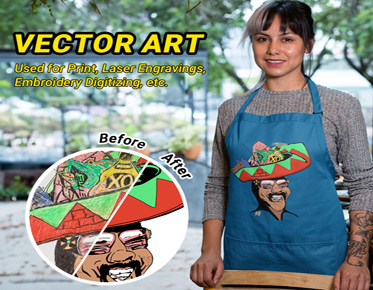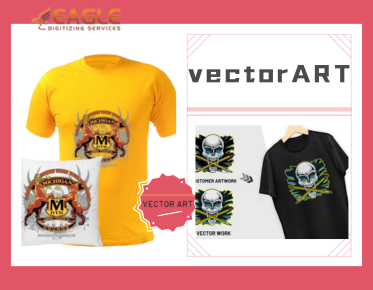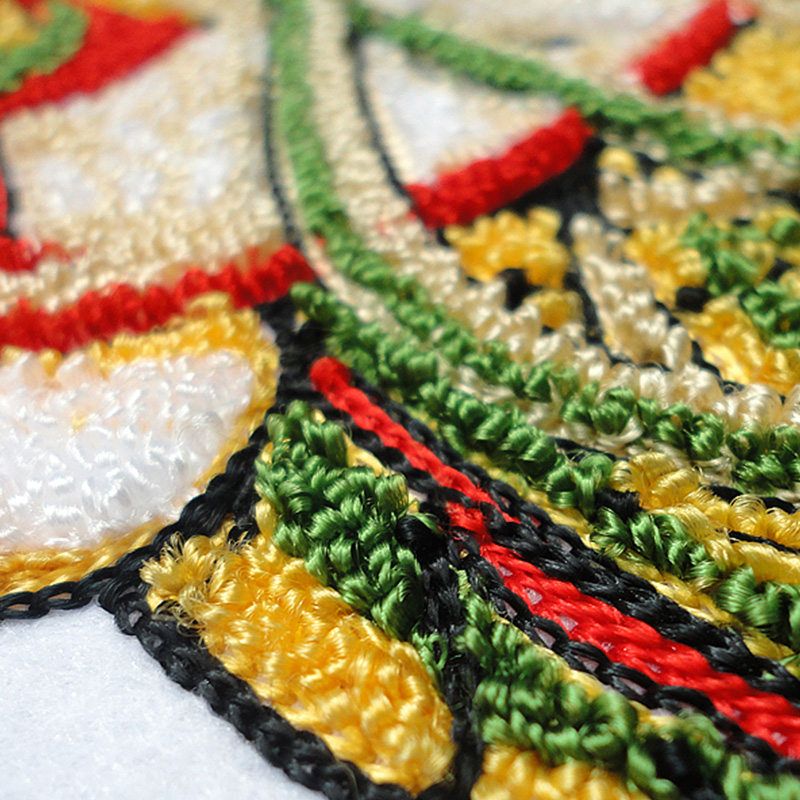Kerning and Leading: Fine-Tuning Your Vector Art Typography
Typography isn't just about picking the right font; it’s an intricate dance of spacing and alignment that can make or break a design. In vector art, achieving impeccable typography requires mastering the subtleties of kerning and leading. These seemingly small adjustments play a crucial role in ensuring that your text not only looks aesthetically pleasing but also maintains optimal readability and harmony within your design. Let’s delve into the nuances of kerning and leading and discover how fine-tuning these elements can elevate your vector art to new heights.
Understanding Kerning and Leading
What is Kerning? The Spacing Between Letters
Kerning is the adjustment of space between individual characters in a word. Unlike uniform spacing, kerning tailors the spacing to achieve visual harmony. It’s about making sure that letters don’t look too close or too far apart, creating a balanced and cohesive appearance. Proper kerning ensures that the text reads smoothly and looks professionally polished.
What is Leading? The Space Between Lines of Text
Leading, pronounced "led-ing," is the vertical space between text lines. Its name originates from the strips of lead used in traditional typesetting. Leading affects how text blocks interact with each other, influencing readability and overall design flow. Proper leading prevents text from appearing cramped and ensures that each line is easily distinguishable from the next.
Why Kerning and Leading Matter in Vector Art
In vector art, kerning and leading are vital for achieving typographic precision. They impact the overall aesthetics and legibility of your design. Fine-tuning these elements helps create a harmonious text layout that enhances the visual appeal and readability of your vector graphics. Mastering kerning and leading allows for a more professional and polished finish in your artistic endeavors.
The Basics of Kerning
The History of Kerning: From Print to Digital
Kerning has evolved from its origins in traditional print media to the digital realm. In the past, typographers manually adjusted letter spacing using metal type, a meticulous process requiring great skill. With the advent of digital design, kerning became automated to some extent, but the principles remain the same. Understanding its history helps us appreciate the art and science behind modern kerning practices.
Types of Kerning: Automatic vs. Manual
Kerning can be categorized into automatic and manual types. Automatic kerning, handled by design software, uses algorithms to adjust spacing based on predefined metrics. While convenient, it may not always achieve perfect results. Manual kerning, on the other hand, involves fine-tuning spacing by hand, allowing for greater control and precision. Combining both methods often yields the best results.
Common Kerning Mistakes to Avoid
Common kerning mistakes include inconsistent spacing, excessive tightness, and uneven gaps. Avoiding these pitfalls requires careful attention to detail. Ensure that spacing between letters is visually consistent and does not compromise readability. Regularly reviewing and adjusting kerning helps avoid these common errors and achieve a polished typographic presentation.
Mastering Manual Kerning
How to Adjust Kerning in Vector Software
Adjusting kerning in vector software involves selecting the text and manually adjusting the space between characters. Most vector design tools offer kerning options in the typography settings. Use the kerning tool to incrementally adjust spacing and evaluate the changes visually. Precision is key, and regularly zooming in helps ensure that adjustments are accurate.
Techniques for Perfect Spacing: Tips and Tricks
For perfect kerning, start by focusing on the most problematic letter pairs, such as those with uneven spacing due to their shapes. Use visual alignment as a guide rather than relying solely on numerical values. Consider the overall word shape and flow to achieve consistent and aesthetically pleasing spacing. Regular practice and experimentation will help refine your kerning skills.
Balancing Aesthetics and Readability
Balancing aesthetics with readability is crucial in kerning. While tight kerning can create a sleek, modern look, it can also impact legibility if overdone. Aim for a balance that enhances the design without sacrificing readability. Test your text in different sizes and contexts to ensure that your kerning choices work well across various applications.
Kerning for Different Typefaces
Serif vs. Sans Serif: Kerning Differences
Serif and sans-serif typefaces require different kerning approaches. Serif fonts, with their decorative strokes, often need more nuanced kerning to accommodate their varied letter shapes. Sans serif fonts, with their clean lines, may require less adjustment but still benefit from careful spacing to maintain visual harmony. Understanding these differences helps tailor your kerning approach to each typeface.
Script and Decorative Fonts: Special Considerations
Script and decorative fonts present unique kerning challenges due to their intricate and varied letterforms. These fonts often feature interconnected or irregular shapes, requiring more precise manual adjustments. Pay close attention to the flow and connection of letters, ensuring that they appear cohesive and balanced while maintaining their distinctive style.
Custom Fonts: Adjusting Kerning for Unique Designs
Custom fonts, designed for specific projects or brands, require tailored kerning adjustments. As these fonts may have unique design elements, manual kerning is often necessary to achieve optimal spacing. Test your custom font in various contexts to fine-tune the kerning and ensure it aligns with the overall design vision.
The Basics of Leading
Understanding Leading and Its Impact on Readability
Leading affects how text blocks interact and impacts overall readability. Adequate leading prevents lines from appearing too cramped, making it easier for readers to follow the text. Properly set leading enhances the visual flow and ensures that the text is comfortable to read, especially in long passages or detailed designs.
Standard vs. Custom Leading: When to Use Each
Standard leading is often used for typical text settings, providing a uniform appearance across different designs. Custom leading, however, allows for adjustments based on specific design needs or stylistic choices. Use custom leading when dealing with unique text layouts or to achieve a particular visual effect that standard leading cannot provide.
How Leading Affects Overall Design and Flow
Leading influences not only readability but also the overall design and flow of text. Adjusting leading can impact the text's visual weight, balance, and interaction with other design elements. Experiment with leading to achieve the desired aesthetic effect and ensure that the text integrates seamlessly into the overall design composition.
Adjusting Leading in Vector Art
How to Set Leading in Popular Vector Software
Setting leading in vector software typically involves accessing the text settings and adjusting the line spacing options. Most vector design tools provide controls for setting both standard and custom leading. Experiment with different leading values to find the optimal spacing for your text and ensure that it enhances the overall design.
Tips for Effective Leading: Avoiding Crowded Text
Effective leading prevents text from appearing crowded or difficult to read. Aim for sufficient spacing between lines to enhance readability and visual appeal. Test your leading adjustments in various sizes and contexts to ensure that the text remains clear and legible, avoiding issues like text overlapping or excessive white space.
Adjusting Leading for Different Text Sizes and Styles
Leading should be adjusted based on text size and style. Larger text may require more leading to maintain readability, while smaller text may benefit from tighter leading. Consider the text's role in the design and adjust the leading accordingly to ensure that it complements the overall layout and enhances the text's impact.
Combining Kerning and Leading for Optimal Typography
How Kerning and Leading Work Together
Kerning and leading are interrelated elements that work together to create a cohesive typographic design. Proper kerning ensures that individual characters are spaced harmoniously while leading controls the vertical spacing between lines. Balancing both elements is essential for achieving a visually appealing and readable text layout.
Creating Harmony Between Text and Design Elements
Achieving harmony between text and design elements involves aligning kerning and leading with the overall design aesthetic. Ensure that text spacing complements other visual elements and supports the design's flow. A harmonious integration of text and design elements enhances the overall visual impact and readability.
Typography and Readability
The Impact of Kerning and Leading on Legibility
Kerning and leading directly impact text legibility by affecting how easily readers can distinguish and follow the text. Proper kerning prevents awkward letter spacing, while appropriate leading ensures that lines of text are comfortably spaced. Together, they contribute to a more readable and user-friendly typographic experience.
Adjusting for Different Mediums: Print vs. Digital
Adjusting kerning and leading for different mediums, such as print and digital, requires consideration of each medium's unique characteristics. Print media may demand different spacing compared to digital screens, due to variations in resolution and size. Tailor your kerning and leading adjustments to each medium to ensure optimal readability and visual appeal.
Ensuring Accessibility: Making Text Easy to Read
Ensuring accessibility involves making text easy to read for all users, including those with visual impairments. Implement kerning and leading adjustments that enhance clarity and legibility, using high-contrast colors and legible fonts. Prioritizing accessibility ensures that your typography is inclusive and effective for a diverse audience.
Kerning and Leading in Different Design Contexts
Web Design: Kerning and Leading for Online Text
In web design, kerning and leading must accommodate various screen sizes and resolutions. Responsive design principles apply, requiring adjustments to ensure that text remains readable and visually appealing across devices. Optimize kerning and leading web content to enhance user experience and accessibility.
Print Design: Ensuring Quality in Physical Media
For print design, kerning and leading play a crucial role in achieving high-quality results. Print media often demands precise adjustments to account for physical attributes such as paper texture and ink spread. Ensure that your kerning and leading choices contribute to a polished and professional print presentation.
Branding and Marketing Materials: Consistent Typography
Consistency in kerning and leading is essential for branding and marketing materials. Uniform typography across different materials reinforces brand identity and ensures a cohesive visual message. Apply consistent kerning and leading to maintain a professional and recognizable brand presence.
Advanced Techniques for Kerning and Leading
Using Grids and Guides: Precision in Typography
Grids and guides provide a framework for precise kerning and leading adjustments. By aligning text with a grid, you can achieve consistent spacing and alignment throughout your design. Utilize grids and guides to enhance accuracy and maintain a structured and balanced typographic layout.
The Role of Typography in Responsive Design
Typography plays a key role in responsive design, adapting to various screen sizes and orientations. Adjust kerning and leading dynamically to ensure that text remains readable and visually appealing across different devices. Responsive typography enhances the overall user experience and maintains design integrity.
Experimenting with Non-Traditional Kerning and Leading
Experimenting with non-traditional kerning and leading approaches can lead to unique and creative typographic effects. Explore unconventional spacing techniques to achieve innovative visual outcomes. While experimenting, ensure that readability and overall design cohesion are maintained. For the first-class online vector conversion, don't hold back from contacting us.
Perfectly tuned typography is the cornerstone of exceptional vector art. Embrace the art of kerning and leading to elevate your designs and achieve a harmonious and visually compelling text presentation. As you refine these skills, your vector art will reach new levels of sophistication and impact, making your designs stand out with clarity and style.



